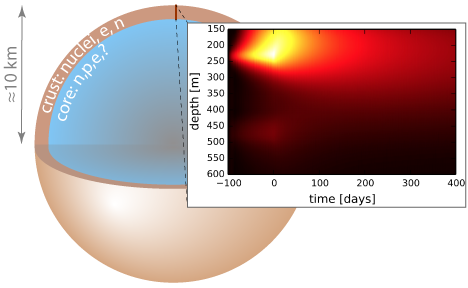
Cutaway of the neutron star in MAXI J0556-332. During accretion, the outermost kilometer of the neutron star—its crust—is heated by compression-induced reactions (inset plot, which shows the temperature within the crust over a span of 500 days). When accretion halts (at time 0 in the plot), the crust cools. By monitoring the surface temperature during cooling, Deibel et al. determined that a strong heat source must be located at a relatively shallow depth of approximately 200 meters. (NB: For illustative purposes, the outdurst duration in this schematic was shortened to 100 days.)
Strong Shallow Heating in MAXI J0556-332
A collaboration led by MSU astronomy graduate student Alex Deibel has modeled the cooling of the neutron star MAXI J0556-332. This neutron star had been accreting hydrogen- and helium-rich gas from a companion star for about 16 months prior to May 2012 when accretion halted. Since then, the neutron star has been steadily cooling except for a brief accretion episode starting about 6 months after the end of the main outburst and lasting about 2 months. The surface temperature of the neutron star has been monitored over this time by the X-ray satellites Chandra, XMM-Newton, and Swift.
What makes MAXI J0556-332 so distinctive is that its surface temperatures were much hotter than any other known neutron star transient. By modeling the neutron star crust temperatures during the accretion outburst and subsequent quiescent cooling (as shown in the figure), Deibel et al. found that the neutron star crust must be strongly heated at a relatively shallow depth of approximately 200 meters. The amount of shallow heating is larger than that inferred for other neutron star transients and is larger than can be supplied by nuclear reactions. This suggests that the heating may be supplied by mechanical energy in the accretion flow, although the reason for its deposition at that depth is unknown.
The high inferred crust temperature makes MAXI J0556-332 an ideal source to test for the presence of neutrino cooling from crust electron capture/beta decay cycles that was recently discovered by Schatz and collaborators. Fits to the cooling surface temperatures disfavor the presence of such reactions. The high crust temperature of this source also make the rate of cooling less dependent on the crust composition. As a result, the rate of cooling depends mostly on the thickness of the neutron star crust: future observations can in principle constrain this crust thickness and hence the surface gravity of the neutron star.